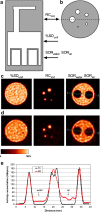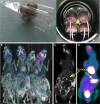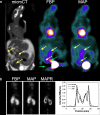The motivations and methodology for high-throughput PET imaging of small animals in cancer research
- PMID: 22790877
- PMCID: PMC3411308
- DOI: 10.1007/s00259-012-2177-x
The motivations and methodology for high-throughput PET imaging of small animals in cancer research
Abstract
Over the last decade, small-animal PET imaging has become a vital platform technology in cancer research. With the development of molecularly targeted therapies and drug combinations requiring evaluation of different schedules, the number of animals to be imaged within a PET experiment has increased. This paper describes experimental design requirements to reach statistical significance, based on the expected change in tracer uptake in treated animals as compared to the control group, the number of groups that will be imaged, and the expected intra-animal variability for a given tracer. We also review how high-throughput studies can be performed in dedicated small-animal PET, high-resolution clinical PET systems and planar positron imaging systems by imaging more than one animal simultaneously. Customized beds designed to image more than one animal in large-bore small-animal PET scanners are described. Physics issues related to the presence of several rodents within the field of view (i.e. deterioration of spatial resolution and sensitivity as the radial and the axial offsets increase, respectively, as well as a larger effect of attenuation and the number of scatter events), which can be assessed by using the NEMA NU 4 image quality phantom, are detailed.
Figures







Similar articles
-
High-throughput small animal PET imaging in cancer research: evaluation of the capability of the Inveon scanner to image four mice simultaneously.Nucl Med Commun. 2010 Oct;31(10):851-8. doi: 10.1097/MNM.0b013e32833dc61d. Nucl Med Commun. 2010. PMID: 20683363
-
Animal PET scanner with a large field of view is suitable for high-throughput scanning of rodents.Ann Nucl Med. 2024 Jul;38(7):544-552. doi: 10.1007/s12149-024-01937-1. Epub 2024 May 8. Ann Nucl Med. 2024. PMID: 38717535
-
NEMA Performance Evaluation of CareMiBrain dedicated brain PET and Comparison with the whole-body and dedicated brain PET systems.Sci Rep. 2019 Oct 29;9(1):15484. doi: 10.1038/s41598-019-51898-z. Sci Rep. 2019. PMID: 31664096 Free PMC article.
-
Small animal positron emission tomography in food sciences.Amino Acids. 2005 Dec;29(4):355-76. doi: 10.1007/s00726-005-0237-2. Epub 2005 Sep 2. Amino Acids. 2005. PMID: 16142524 Review.
-
Positron emission tomography/computed tomography.Semin Nucl Med. 2008 May;38(3):152-66. doi: 10.1053/j.semnuclmed.2008.01.003. Semin Nucl Med. 2008. PMID: 18396176 Review.
Cited by
-
Impact of a multiple mice holder on quantitation of high-throughput MicroPET imaging with and without Ct attenuation correction.Mol Imaging Biol. 2013 Oct;15(5):569-75. doi: 10.1007/s11307-012-0602-y. Mol Imaging Biol. 2013. PMID: 23479323 Free PMC article.
-
PET Imaging of Estrogen Receptors Using 18F-Based Radioligands.Methods Mol Biol. 2022;2418:129-151. doi: 10.1007/978-1-0716-1920-9_9. Methods Mol Biol. 2022. PMID: 35119664
-
Accurate molecular imaging of small animals taking into account animal models, handling, anaesthesia, quality control and imaging system performance.EJNMMI Phys. 2015 Dec;2(1):31. doi: 10.1186/s40658-015-0135-y. Epub 2015 Nov 11. EJNMMI Phys. 2015. PMID: 26560138 Free PMC article.
-
NEMA NU 4-Optimized Reconstructions for Therapy Assessment in Cancer Research with the Inveon Small Animal PET/CT System.Mol Imaging Biol. 2015 Jun;17(3):403-12. doi: 10.1007/s11307-014-0805-5. Mol Imaging Biol. 2015. PMID: 25465391
-
Scatter characterization and correction for simultaneous multiple small-animal PET imaging.Mol Imaging Biol. 2014 Apr;16(2):199-209. doi: 10.1007/s11307-013-0683-2. Mol Imaging Biol. 2014. PMID: 23990147
References
Publication types
MeSH terms
LinkOut - more resources
Full Text Sources
Research Materials

